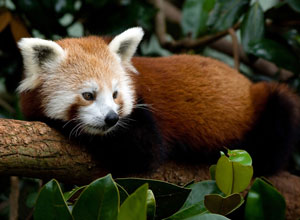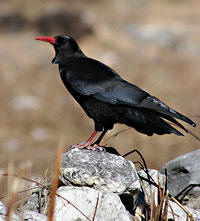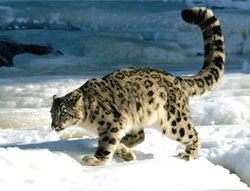|
|
Wildlife Sanctuaries in Nepal and Sikkim |
| Nepal Wildlife
Sanctuaries |
|
Annapurna Conservation Area
Annapurna Conservation Area is the first and the largest
conservation area in Nepal. It covers an area of 7,600
square kms. and is located in mid-western Nepal. About
1,226 species of plants, including 38 species of
orchids, 9 species of rhododendron and many varieties of
fish can be seen in this area. It is also the home of
blue sheep and snow leopards. The Impeyan pheasant, and
various varieties of butterflies and insects can also be
seen in this park. |
 |
|
|
|
|
Kanchanjunga Conservation Area
Kanchanjunga Conservation Area is situated just below the
looming mountains of Kanchanjunga. The conservation area is
spread in an area of 2,035 square kms, and made up of alpine
grasslands, rocky outcrops, dense temperate and subtropical
forests, and river lowlands. The Kanchanjunga Conservation
Area is situated in Northeast Nepal in Taplejung district and
bordered by Tibet and Sikkim in India in the east. The area is
a vast repository of flora and fauna. During spring, the area
has an excellent display of rhododendrons, orchids, lilies,
primula and many other flowers. Here you can see 15 of Nepal's
28 endemic flowering plants. The wildlife animals in the park
includes the endangered snow leopard, Himalayan black bear,
musk deer, red panda, blue sheep, rhesus macaw. Impheyan
pheasant, red-billed blue magpie, shy drongo are some of the
birds found in the area.
Dhorpatan Hunting Reserve
Dhorpatan Hunting Reserve is the only wildlife reserve in
Nepal which is legalized for hunting. The reserve adjoins
Rukum, Myagdi and Baglung districts below the Dhaulagiri range
in West Nepal. This reserve was established in 1987, and
allows sport hunting and preserve a representative
high-altitude ecosystem. It covers an area of 1,325 square kms.
The reserve offers some game animals for controlled hunting.
The vegetation in this region includes alpine, sub-alpine and
high-temperature vegetation. Fir, pine and spruce are some of
the trees found in the region. Some of the wildlife animals
and birds found in the reserve are the blue sheep, snow
leopard, tahr, langur, ghoral, black bear, barking deer, mouse
hare, wild boar, pheasants and partridges. The endangered
animals in the reserve include musk deer, wolf, red panda and
birds like cheer pheasant and Danphe.
Sagarmatha National Park
The Sagarmatha National Park is located to the north-east of
Kathmandu in the Khumbu region of Nepal. This park includes
the Mount Everest, the highest peak in the world, Lhotse Shar,
Cho Oyu, Ama Dablam, Pumori, Kangtega, Gyachung Kang,
Thamserku and Kwangde. Sagarmatha National Park covers an area
of 1,148 square kms. and consists of upper areas of rivers
Dudh Koshi, Bhote Koshi and Imja Khola. The rugged region with
deep gorges and glaciers is locally called Khumbu, and is home
of the Sherpas, whose lives are interwoven with the teachings
of Buddhism. The park was declared as a World Heritage Site in
1979. The vegetation in the park includes the rhododendron,
birch, blue pine, juniper, silver fir, scrub, alpine plants,
rock and snow. During spring and summer season, the hillsides
around the villages of Namche Bazaar, Khumjung, Thyangboche
and Thame are splashed with the colors of different species of
rhododendron. Some of the animals which can be seen in the
Sagarmatha National Park are the Himalayan tahr, ghoral, musk
deer, mouse hare, weasel, jackal, Himalayan black bear, wolf,
marten, Himalayan mouse hare, jackal, langur monkey and snow
leopard. Some of the birds which can also be seen in this park
are Impeyan pheasant, blood pheasant, snow cock, snow pigeon,
red billed and yellow billed chough, Himalayan griffin vulture
and lammergeier.
Royal Bardia National Park
The Royal Bardia National Park is situated in the mid far
western Terai region of Nepal, east of the Karnali River. The
Royal Bardia National Park was established in 1988 and covers
an area of 968 square kms. It is the largest and most
undisturbed park in the Terai lowlands. About 1500 people who
used to live in this valley have been resettled elsewhere.
Most of the part of the park is covered with Sal trees,
grasslands, savanna and riverine forests. The one-horned
rhino, tiger, wild elephant, black buck, swamp deer, gharial
crocodile, marsh mugger, Gangetic dolphin, snakes, lizards and
fishes are the major attractions of this park. More than 200
species of resident and migratory birds including the Bengal
florican, lesser florican and Sarus crane can also be seen in
this park. |
|
|
|
Langtang National Park
Langtang National Park is located in the Central
Himalayas and is the nearest national park from
Kathmandu. The area extends from 32 km north of
Kathmandu to the Nepal-China (Tibet) border. This
national park was established in 1976 and covers an area
of 1,710 square kms. Langtang encloses two river areas,
one drains from west into the Trisuli River and the
other drains from east to the Sun Koshi river. The
vegetation in the park includes the subtropical forest,
temperate oak forest, pine forests, alpine scrub and
grasses. Blue pine, hemlock, spruce, Oak, chir pine,
maple, fir and various species of rhododendron are the
main forest species. About 45 villages are situated
|
 |
|
|
within the
park boundaries, but they are not under park jurisdiction. The
area is also the home of several ethnic groups which have
influenced the natural environment over the centuries. The
wildlife attractions in the Langtang National Park are Deer,
Himalayan Tahr, Ghoral, Seraw, Rhesus monkey, Common langur,
Wild dog, Musk deer, Himalayan black bear and Himalayan red
panda. The Langtang region is a very important transit route
for migratory birds.
Shey-Phoksundo National Park
Shey-Phoksundo National Park is situated in the mountain
region of western Nepal and cover parts of Dolpa and Mugu
districts. Shey-Phoksundo National Park is the largest
national park in Nepal. This park was established in 1984 and
covers the area of 3,555 square kms. This park is roughly
divided into Himalayan range and the river valleys. The
Himalayan region has desert type vegetation that mainly
consists of dwarf juniper and caragana shrubs while the river
valley consists of blue pine, spruce, poplar, cypress, deodar,
fir and birch trees. The park is a prime habitat for snow
leopard and blue sheep. Other animals which are found in the
park are the black bear, Himalayan weasel, langur, ghoral,
Himalayan tahr, serow, leopard, wolf, jackal, Himalayan mouse
hare, yellow-throated marten and rhesus monkeys. The park is
equally rich in various species of birds like the Impeyan
pheasant (danphe), blood pheasant, cheer pheasant, red and
yellow billed cough, raven, jungle crow, snow partridge and
many others.
Makalu-Barun National Park
Makalu-Barun National Park is located in the Sankhuwasabha and
Solukhumbu Districts in the northeast Nepal at the Nepal-Tibet
border. This park was established in 1992 and covers an area
of 2,330 square kms. This is the only protected area in Nepal
with strict laws for nature conservation. This park is
bordered by the Arun River in the east, Sagarmatha National
Park in the west, the Nepal-China border in the north and the
Saune Danda (ridge) in the south. This park has some of the
richest and most unique varieties of plants and animals in
Nepal. The vegetation in the park includes fir, birch, herbs,
grasses, rhododendron and oaks. There are 47 varieties of
orchids, 67 species of economically valuable medicinal and
aromatic plants, 25 varieties of rhododendron, 19 species of
bamboo, 15 oaks, 86 species of fodder trees and 48 species of
primrose. The wildlife in the park includes red panda, musk
deer, clouded leopard, barking deer, wild boar, Himalayan
black beer, snow leopard, ghoral, Himalayan tahr, Himalayan
marmot, weasel, common langur monkey and serow. The Arun River
system contains 84 varieties of fish.
Rara National Park
Rara National Park is located in Northwest Nepal, about 371
kms. from Kathmandu. This park was established in 1976 and
covers an area of 106 square kms. This is the smallest park in
Nepal. The main attraction of the Rara National Park is the
Rara Lake, which is the biggest lake of Nepal. Most of the
park, including Rara lake, lies in Mugu District and a small
area is within Jumla District of Karnali Zone. The park is
covered by coniferous and deciduous forest. Some of the trees
which are found in this park are blue pine, black juniper,
West Himalayan spruce, oak, Himalayan cypress, fir, oak,
birch, Indian horse-chestnut and walnut. The wild animals
which are found in this park are musk deer, leopard, black
bear, ghoral, Himalayan black bear, Himalayan tahr and wild
boar. Snow trout is the only fish found in the lake. Some of
the birds like great-crested grebe, snow cock, black-necked
grebe, red-crested pochard, kalij pheasant, chakor partridge,
Impeyan pheasant and blood pheasant can also be seen in this
park.
Royal Shukla Phanta Wildlife Reserve
The Royal Shukla Phanta Wildlife Reserve is located in the
southern part of far-west Nepal in the Kanchanpur District.
This park was established in 1976 and covers an area of 305
square kms. Sal, asna, simal, karma, khair and sissoo trees
are found along the riverside. The reserve is a prime habitat
for swamp deer. Other wild animals include wild elephant,
tiger, hispid hare, blue bull, leopard, chital, hog deer and
wild boar. Birds of 200 different varieties, including the
rare Bengal florican, are found here. Marsh mugger, crocodile,
Indian python, monitor lizard and snakes like cobra, krait,
and rat snake are also found here.
Koshi Tappu Wildlife Reserve
The Koshi Tappu Wildlife Reserve lies in the flood plains of
the River Sapta Koshi in Saptari and Sunsari Districts of
Eastern Nepal. This park was established in 1976 and covers an
area of 175 square kms. This reserve is a favorite place for
the bird enthusiasts. The vegetation in the reserve includes
tall grasses with few patches of Sissoo and Khair scrub forest
and deciduous mixed riverine forest. This reserve offers a
habitat for the wide variety of wildlife. The last surviving
herd of wild buffaloes was found here. Some other species of
animals include wild boar, hog deer, spotted deer, blue bull,
crocodile, gharial and the Gangetic dolphin. About 280 species
of birds, including ducks, ibises, egrets, herons, swamp
partridge and Bengal floricans are also found here. The Koshi
Barrage is an extremely important place for the migratory
birds. Other animal species include the crocodile, gharial and
the Gangetic dolphins. Commercial fishing is also an important
activity here. |
|
|
|
Sikkim Wildlife
Sanctuaries |
|
Kanchendzonga National Park
Kanchendzonga National Park is the largest national park
in Sikkim. This park covers an area of 850 square km. It
is bounded in the north by the Tent Peak and the ridge
of the Zemu glacier, in the east by the ridge of the
Mountain Lamo Angden, in the south by Mount Narsing and
Mount Pandim and in the west by the mighty Kanchendzonga
and the Nepal peak. The park has remained ecologically
untouched due to such features and so it provides a
natural protection to the plants and animals. Many
places in this park have never been touched by
|
 |
|
|
man, and so
there are chances that new species can also be discovered
here. The animals which are found here are the Snow Leopard,
Himalayan Black bear, Red Panda, Barking deer and various
other animals.
Fambong Lho Wildlife Sanctuary
Fambong Lho Wildlife Sanctuary is located about 20 km from
Gangtok. This wildlife sanctuary covers an area of about 5200
hectares above the road between Singtam and Dickchu. The
highest point is located at a place called Tinjure at 7000
feet where a wooden observation tower of the Forest Department
exists. Himalayan Black Bear, Red Panda, Civet Cat and many
varieties of birds and butterflies can be found in this
sanctuary.
Maenam Wildlife Sanctuary
The Maenam Wildlife Sanctuary is located in South Sikkim above
the town of Rabongla. This wildlife sanctuary covers an area
of about 3500 hectares with its highest point being at Maenam
at 10600 feet. The Red Panda, Leopard Cat, Civet Cat, Blood
pheasant, Black eagles and other animals can be found in this
wildlife sanctuary. |
|